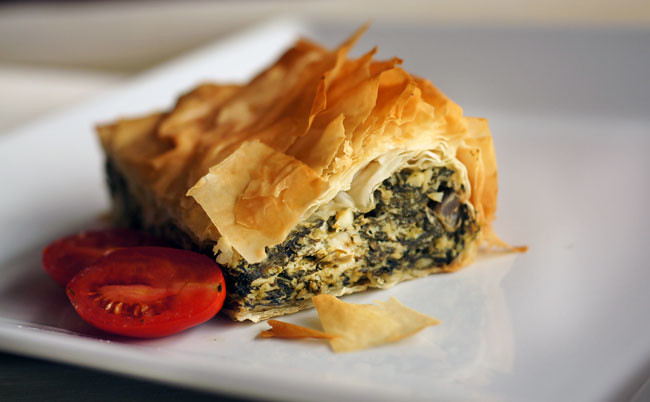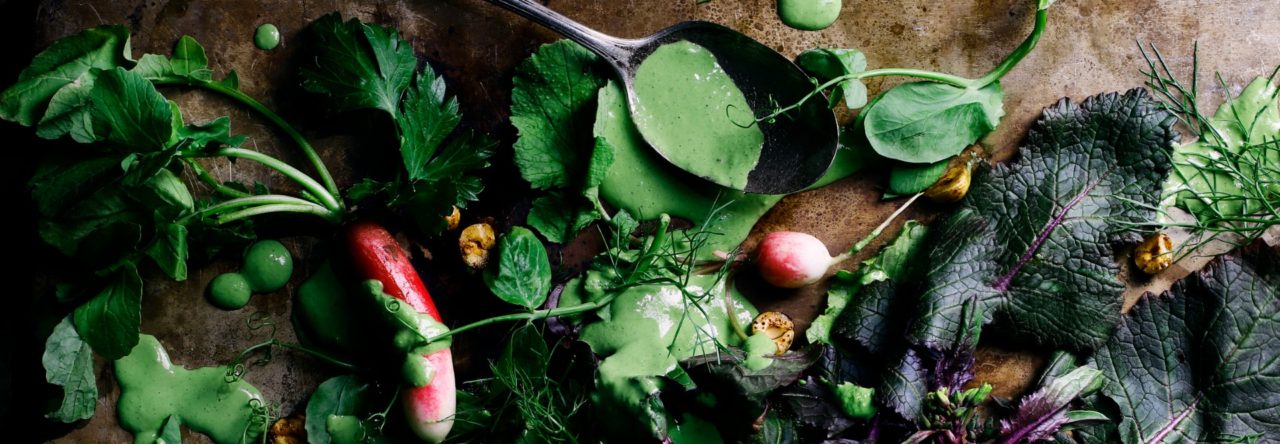
Spinach vs. Chard: everybody wins
My first apartment kitchen in the mid 90’s and I’m holding a vegetable never encountered before, at least not until I moved only a year ago to the wilds of NYC. I know it’s edible, tasty even, but it’s casual resemblance to rhubarb makes me a touch concerned. One of my roommates wanders into the kitchen.
“What’s that?”
“It’s chard. You’ve never seen chard before?”
“What the hell is chard? Why would anyone want to eat something called ‘chard’ ?!”
I couldn’t tell you why I bought chard that day. At nearly $3 for an organic produced bundle of stalks and leaves, purchased at natural food store a 20 minute subway ride away, it’s not the most obvious choice for a then early 20-something living on a salary more becoming of iceberg lettuce from the C-Town supermarket down the street. But it was so green. So big and leafy. So…stalky?
It’s been too long ago to recall what I made of it that day, but I know it was good enough to merit repeat purchases and bewildering looks from the roommates. Years later, chard seems so mainstream: my circle of friends have expanded their own circle of vegetables to include regular helpings of chard as much as I do. One friend, a long-time spinach devote (spinach salads, pies, and pizzas are mainstays) proclaimed “it’s better than spinach”! I’m not about to take sides, but there are times when chard really holds it’s own against it’s more expected vegetable peer.
If you’re farm share is anything like mine, you’ve probably had your own avalanche of chard in a rainbow of colors all spring and headstrong through the summer. Originally I had in mind for this post a recipe for veggie-ful chard pancakes; I adore savory pancakes. But, on a whim and an extra box of filo dough that chard found it’s way into an updated version of my vegan Greek spinach pie recipe.
The usual crumbled tofu filling is now enhancing with the buttery magic of soaked, pureed cashews and a touch of miso for salty depth. Chard, stems and all, are cooked and minced as fine as possible in lieu of spinach; it adds a hearty crunch and subtle sweetness to this enduring favorite wrapped in melting layers of crisp filo dough. Or go old school and use half spinach, half chard; everybody wins in this contest of leafy greens!
Greekish Chard or Sometimes Spinach Pie
This style of spinach pie–two layers of dough sandwiching the filling in a lasagna pan– is the easiest method of assembly. Serve with a crisp tomato, cucumber and crunchy lettuce salad dressed with abundant lemon and olive oil for fresh yet filling entree.
Chard tip: The younger and fresher the chard, the faster it cooks down, especially the stems.
Filling:
1 pound soft Chinese style tofu, drained and lightly pressed
1 cup whole unroasted cashews, soaked in hot water until soft and drained
4 cloves garlic
3 tablespoons nutritional yeast
1 teaspoons sea salt
4 tablespoons lemon juice
2 tablespoons olive oil, divided
2 teaspoons light-colored miso
2 pounds fresh chard or spinach or half and half
1 cup roughly chopped fresh dill
4 scallions, root ends trimmed and finely chopped
1/2 teaspoon ground black pepper
Filo crust:
1 package frozen filo dough, completely thawed and handled according to package directions
1/4 cup non hydrogenated vegan butter (such as Earth Balance), melted
1/4 cup extra virgin olive oil
1. With your fingers crumble the tofu into a mixing bowl. In a food processor pulse together drained cashews, garlic, nutritional yeast, sea salt, lemon juice, half of the olive oil and miso; blend until a thick paste forms, scraping down the sides of the food processor frequently with a rubber spatula. Scrape cashew mixture into the bowl with the tofu and set aside.
2. Wash and dry chard. Stack a few leaves, roll them into a tight cigar and chop the leaves and stems as finely as possible. In a large deep skillet heat the olive oil over medium heat and add chard. Stir frequently and cook chard until wilted and darker in color, about 4-5 minutes. Remove from heat and let cool enough to handle.
3. Grab a handful of cooked chard and with both hand firmly squeeze to remove as much liquid as possible; you may want to do this over another mixing bowl or the sink. Add squeezed chard to tofu. Repeat with remaining chard and discard any leftover cooking liquid. Add dill, scallions and black pepper and mix the chard, tofu and cashew mixture thoroughly. Taste the mixture. Add more lemon juice or salt as desired for a tangier/saltier flavor.
4. Preheat oven to 400 degrees. Spray a 9 x 13 x 2 inch metal baking pan with cooking spray. Set up filo dough for working as directed on the package. I usually layer it between slightly damp, clean kitchen towels, work as fast as possible and always cover the filo after removing a sheet. In a small bowl stir together melted vegan butter and olive oil and have handy a pastry brush. Fit a sheet of filo into the bottom of the pan and gently brush with oil mixture. Repeat layering/brushing until half of the filo has been used. Evenly press the tofu chard filling over the filo, making sure to press it into the edges of the pan and fold the hanging edges of the dough over the filling. Now take a sheet of filo and layer half of it over the filling, brush with the oil mixture and fold the remaining half over the dough, taking care to press the edges into the filling. Repeat with the brushing, folding and pressing with the rest of the filo. Brush top with any remaining oil and bake for 35-40 minutes, until the top of the pie is a rich golden brown and the top looks tasty and flaky. Let cool for 10 minutes and slice with a thin, sharp knife. I even think this pie tastes best served room temperature the next day!








